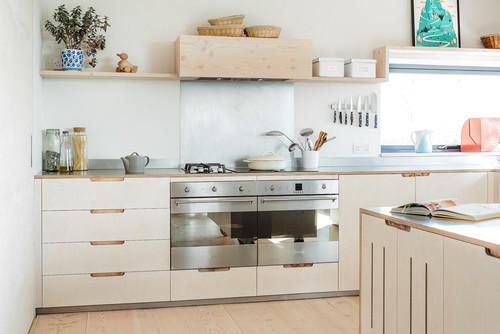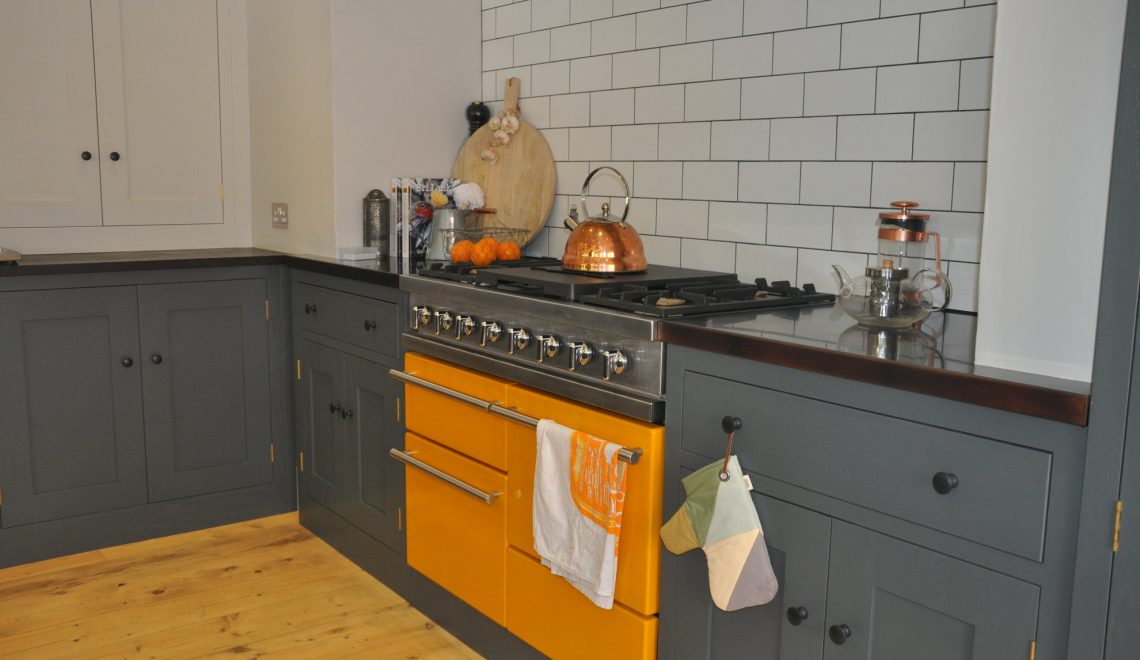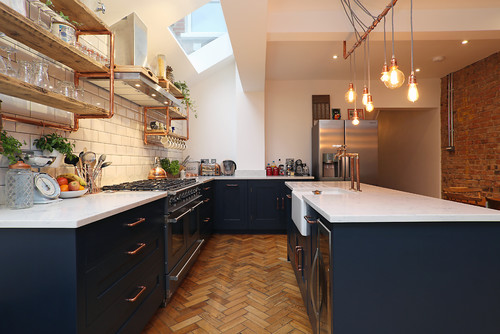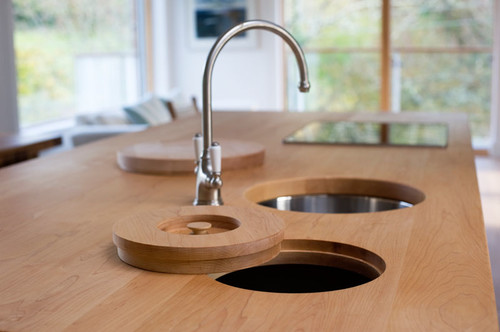In most family homes the kitchen is the go-to hub, a bustling, high traffic area which needs to function efficiently and reflect the style and character of its occupants. Kitchens are often the first space that people look to renovate and here I give you my top 5 eco tips on how to make your kitchen as green and healthy as possible.
Focus on quality and durability
I think the saying “if you buy cheap, you buy twice” applies nowhere better than the kitchen. In a busy, family kitchen imagine the number of times the tap is turned on, the cutlery drawer pulled out, the fridge opened – if the mechanisms for these things are not robust then they are sure to fail with constant use. So, in terms of kitchen units and appliances focus on durability because a large part of eco-renovation is about ensuring interiors stand the test of time. When you’re sourcing kitchen units check what hinges are being used because they can affect the performance and longevity of the cabinet more than the choice of wood or finish. British or German made hinges are best (Armac Martin, Grass and Blum are all excellent quality) but avoid Chinese or Indian brands. Also, think about the ability to recondition fittings when they’ve taken a few knocks – painted cabinets are great because they can be easily touched-up and refreshed with a lick of paint. Specialist decorators, such as Nicky Jones, can transform a tired, dated looking kitchen without ripping out a single unit.
 Photo by Sustainable Kitchens – units built using FSC wood, plywood classed as E1 and hinges made by British firm Armac Martin.
Photo by Sustainable Kitchens – units built using FSC wood, plywood classed as E1 and hinges made by British firm Armac Martin.Incorporate something antique or reclaimed and let it sing
I think a lot of fitted kitchens can be a bit bland and samey. To avoid this and to make an individual, eco statement incorporate something that’s reclaimed or antique. Whether it’s a set of old brass taps; an antique chandelier hanging over the island; a set of open shelves made from scaffold planks and copper pipes; or a French armoire to house your plates and glasses. An idea I’ve had for our new kitchen is to buy some of these mahogany cabinet fronts from Retrouvius and use them as the doors on an overhead wall unit.

Think ventilation
It’s not an exciting topic, I know, but one of the hidden costs of making our homes more energy efficient is poor air quality and the kitchen is the place where it’s essential to think about ventilation. The April edition of Which? magazine has results from air quality tests performed on 3 houses from different periods. In all 3 houses they found worryingly high levels of volatile organic compounds (VOCs) and high particulate and carbon dioxide concentrations in the kitchen spaces. VOCs and particulates can cause allergies and lung irritation whilst high levels of CO2 leads to dizziness and headaches.
If you’re building a new kitchen extension then it’s definitely worth thinking about mechanical ventilation with heat recovery (MVHR). The Green Building Store are highly regarded for their MVHR design service and I’m using them to install the ventilation system in our low energy extension. If you’re not doing such a big overhaul then leave a generous budget for an extractor fan with a powerful motor, ideally externally vented.
If you’re really worried about indoor allergens or have asthma sufferers in the house then you should inquire about the formaldehyde levels in your units. Many kitchen carcasses are made from plywood but by ensuring that they’re classed as E1 then they’ll have the lowest levels of formaldehyde and won’t pollute your kitchen space. Also, use low VOC paints for cabinetry (see my 22nd November post on Eco Paints Demystified) and check out Sustainable Kitchens who build beautiful, eco friendly kitchens from sustainably sourced wood and plywood. Devol also have their Sebastian Cox range which is made entirely from British sourced woods.
Buy energy efficient appliances
With the number of appliances in kitchens increasing and the ever rising cost of electricity, choosing energy efficient appliances is both good for the planet and for your bank balance. Appliances are rated from A+++ (most efficient) to D (least). Which? undertake energy assessments of appliances and label the most efficient ones as Energy Savers. The most important appliances to ensure are energy efficient are fridges, freezers and ovens.
Fridges and freezers are switched on all the time and use about 20% of the electricity in an average house. Since 2012 all fridges and freezers must have an energy rating of at least A+ but the difference in energy consumption between an A+ and an A+++ fridge can amount to £190 over its lifetime. It’s also possible to buy fridges with an energy saving holiday mode. Similarly, an A+++ electric oven will use 60% less energy than a B rated one so it really does make economic sense to buy the more energy efficient model even if it is a bit more expensive. A final note on these energy guzzling appliances is don’t oversize them because larger appliances consume significantly more energy than smaller ones and in the case of ovens take considerably longer to heat up.
Build recycling facilities into your kitchen
The more intuitive you make the recycling in your kitchen the more you’ll do it. There are lots of ingenious ways of incorporating recycling bins into kitchen units. Think about what your local authority requires in terms of separation of materials and incorporate the appropriate divisions into your bins.
To encourage you to recycle more, make your recycling bin larger and a little more accessible than your landfill bin and label both bins clearly. In terms of food waste, locate this close to your prep area and make sure that everything can be swept into it easily. If you’re able to make compost then think about having two separate divisions for cooked and uncooked food. Also make sure your food waste container has a close fitting lid to minimise smells.









Thank you for sharing this information on my kitchen remodel part 2. It was useful and interesting. You indeed have written it in a layman way so that anyone can understand and work accordingly. You have done a great job.
Thanks so much for your kind words and I’m glad you found it informative and interesting.
I love this blog, and great that you have shared these about 5 top eco tips for kitchen renovation. I enjoy reading this blog; hope to learn more from your blog in future. Great points!! I love this blog; please keep updated us with such information.
Thanks very much – I’m glad you liked it!
Hi,
I am in UK and trying to find formaldehyde free kitchen cabinets, low VOC….
Help
Sharan
Good to hear from you. I’m afraid the answer isn’t that simple.
One option is to get the cabinets made by a local joiner using wood. This has its issues though because it can be expensive and wood moves with fluctuations in temperature and humidity which is why kitchen companies use mdf and plywood because they are structurally stable. You could use a type of wood called Accoya which is incredibly stable but it would be very expensive. The Sebastien Cox Kitchen by Devol uses British wood.
Another option is to use a combination of wood and plywood but make sure that the plywood is E1 which means that it has very low formaldehyde levels. Sustainable Kitchens in Bristol are very up on all things environmental and they have a bespoke range and a cheaper range. It’s definitely worth giving them a call.
There is a zero formaldehyde mdf called medite clear https://mdfosb.com/en/medite/products/medite-clear and something called Smartply which is a very eco-friendly plywood https://mdfosb.com/en/smartply/about
Of the big, chain manufacturers of kitchens I’m not aware of any that make formaldehyde-free kitchens. You might find that some of them use E1 ply or mdf but they tend not to get into this level of detail in their marketing or on their websites so you’d need to call them up to find out more. You could also try this kitchen company https://milestone.uk.net/
I hope this helps. Sorry not to be able to give you a definitive answer.
Hi Sharan, sorry it’s taken me a while to get back to you. Formaldehyde free kitchen cabinets are difficult and you really have to drill down into the detail of the product descriptions and often call up the manufacturers to find out about levels. Companies are getting better at disclosing formaldehyde and VOC levels so most of them will know what you’re talking about when you speak to them. Bear in mind that all wood contains small levels of formaldehyde but products labelled as being E1 have de minimis levels. Also there’s a company called medite smartply which produces zero added formaldehyde plywood and an mdf product call medite clear.